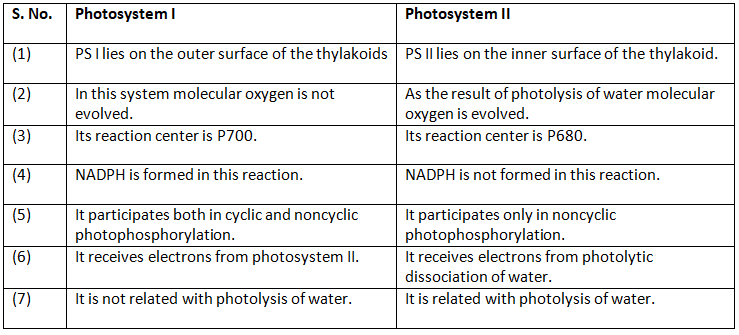Modern Concept Of Photosynthesis - 2 | Agriculture Optional for UPSC PDF Download
Light phase
Transfer of energy
When a photon of light energy strikes a chlorophyll molecule, one of its electrons is raised from its ground or singlet state to an excited singlet state. This electron returns to the ground state within a very short time (approximately 109 seconds). The energy absorbed by the chlorophyll molecule during this process appears as radiation energy when the electron returns to the ground state. Some electrons fail to return to their partner electrons and temporarily get trapped at a higher energy level (triplet state) due to a spin reversal. Eventually, they return to the ground state, losing excess energy in the form of radiation, a phenomenon known as phosphorescence.
When electron is raised to higher energy level, it is called at second singlet state. It can lose its energy in the form of heat also. Migration of electron from excited singlet state to ground state along with the release of excess energy into radiation energy is of no importance to this process. Somehow when this excess energy is converted to chemical energy, it plays a definite constructive role in the process.
Quantum yield
- The rate or yield of photosynthesis is measured in terms of quantum yield or the evolution of oxygen (O2). Quantum yield is defined as the number of O2 molecules evolved per quantum of light absorbed in photosynthesis.
- The quantum requirement for photosynthesis is 8, meaning that 8 quanta of light are required to produce one mole of O2.
- Therefore, the quantum yield is 1/8, which is equivalent to 12%.
Emerson effect and Red drop
R. Emerson and C.M. Lewis observed that the quantum yield of photosynthesis decreases toward the far red end of the spectrum (around 680 nm or longer). This decrease is referred to as the "red drop." Additionally, they observed that photosynthetic efficiency increases when light of shorter wavelengths (less than 680 nm) is supplied simultaneously with light of longer wavelengths (680 nm or longer). This phenomenon is known as the Emerson effect or Emerson enhancement effect, which is represented by the formula: E = Quantum yield in combined beam - Quantum yield in red beam / Quantum yield in far red beam.
Emerson et al. (1957) further observed that photosynthetic efficiency of light of 680nm or longer is increased if light of shorter wavelengths (Less than 680nm) is supplied simultaneously. When both short and long wavelengths were given together the quantum-yield of photosynthesis was greater than the total effect when both the wavelengths were given separately. This increase in photosynthetic efficiency (or quantum yield) is known as Emerson effect or Emerson enhancement effect.
Two pigment systems
The Emerson effect highlights the existence of two distinct photochemical processes associated with two different groups of pigments:
- Pigment System I or Photosystem I (PS I) involves chlorophyll a 670, chlorophyll a 683, chlorophyll a 695, and P700. It absorbs wavelengths both shorter and longer than 680 nm.
- Pigment System II or Photosystem II (PS II) includes chlorophyll a 673, P680, chlorophyll b, and phycobilins. This system absorbs only shorter wavelengths than 680 nm. P680 acts as the reaction center in PS II.
Comparison of photosystem I and photosystem II
Photophosphorylation
Light phase involves the interaction of two pigment systems. It is shown that during the light reaction, not only is reduced NADP formed and oxygen evolved, but ATP is also generated. The formation of high-energy phosphates (ATP) depends on light and is called photophosphorylation.
Photophosphorylation is of two types:
- Cyclic Photophosphorylation: This process involves only Photosystem I (PS I) and is dominant in bacteria. It includes the cyclic flow of electrons, and if NADP is not available, this process occurs. Electrons are raised to a higher energy level, captured by a primary acceptor, and transferred through several molecules while losing potential energy, leading to ATP synthesis. No reduction of NADP to NADPH+H+ occurs in this process.
- Non-Cyclic Photophosphorylation: This process, dominant in green plants, involves both Photosystem I (PS I) and Photosystem II (PS II). Electrons flow unidirectionally and are used in the reduction of NADP to NADPH2, involving the utilization of water and the evolution of oxygen. High-energy electrons released from P-680 are not cycled back to P-680, and they pass through a series of molecules to generate ATP. ATP is synthesized at only one step in this process.
Pseudocyclic photophosphorylation: There is also a variation known as Pseudocyclic Photophosphorylation. In the absence of CO2 and NADP, chlorophyll molecules, when illuminated, can produce ATP from ADP and inorganic phosphate (iP) in the presence of FMN or vitamin K and oxygen. This process is oxygen-dependent and repeatedly self-repeats, producing ATP without net chemical changes and requiring only one molecule of water for ATP production. It is also known as pseudocyclic photophosphorylation.
|
52 videos|224 docs
|
















